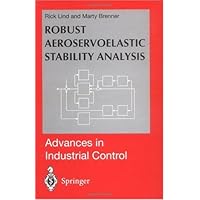
Average Reviews:

(More customer reviews)Make no mistake, this is the best and modern introduction in Aeroservoelasticity and the mu framework. However, unless you are deeply interested in the subject and you need comprehensive information, most of the book (I'd say 75% of its content) can be accessed free as the NASA TP-1998-206543 that can be found FREE for download at
[...]
(or go at the NTRS website [...] and search for "206543"). I'm pretty sure the rest of the book can be found in the other NASA reports and papers signed "Brenner".
It's not nice to undermine the authors from cashing royalties, but it's also not nice to ask people to pay for a book that's based on research funded with taxpayer money.
Otherwise the book (and therefore the NASA report) is VERY WELL WRITTEN. But it's for experts.
Click Here to see more reviews about: Robust Aeroservoelastic Stability Analysis: Flight Test Applications (Advances in Industrial Control)
This book introduces a new method of analyzing aeroelasticity for flexible aircraft by applying robust stability theory. This method was developed to address several concerns with traditional methods and improve the efficiency of flight flutter testing. One advantage to this method is the ability to consider modeling errors in the analysis and generate a worst-case flutter margin. Another advantage is the ability to incorporate flight data directly into the analysis to ensure the model accounts for poorly modeled properties that are observed on the aircraft. The material covered provides a detailed explanation of the method to analyze robust stability margins using µ-analysis. It shows how to formulate aeroelastic models in the µ framework using standard state-space concepts. It also presents several ways to represent modeling errors in this framework and discusses how these errors relate to typical errors in aeroelastic models. Algorithms are listed that demonstrate how to apply these robustness concepts to general aircraft models and compute worst-case stability margins. Engineers working with flight test programs will be particularly interested in the material detailing methods of using flight data to update theoretical models and associated uncertainty descriptions. These methods represent a dramatic improvement over traditional analysis that separately analyze flight data and theoretical models. Incorporating the flight data presents the distinct benefit of ensuring the uncertainty description is a realistic representation of modeling errors so the worst-case stability margins are neither overly optimistic or conservative.

0 comments:
Post a Comment